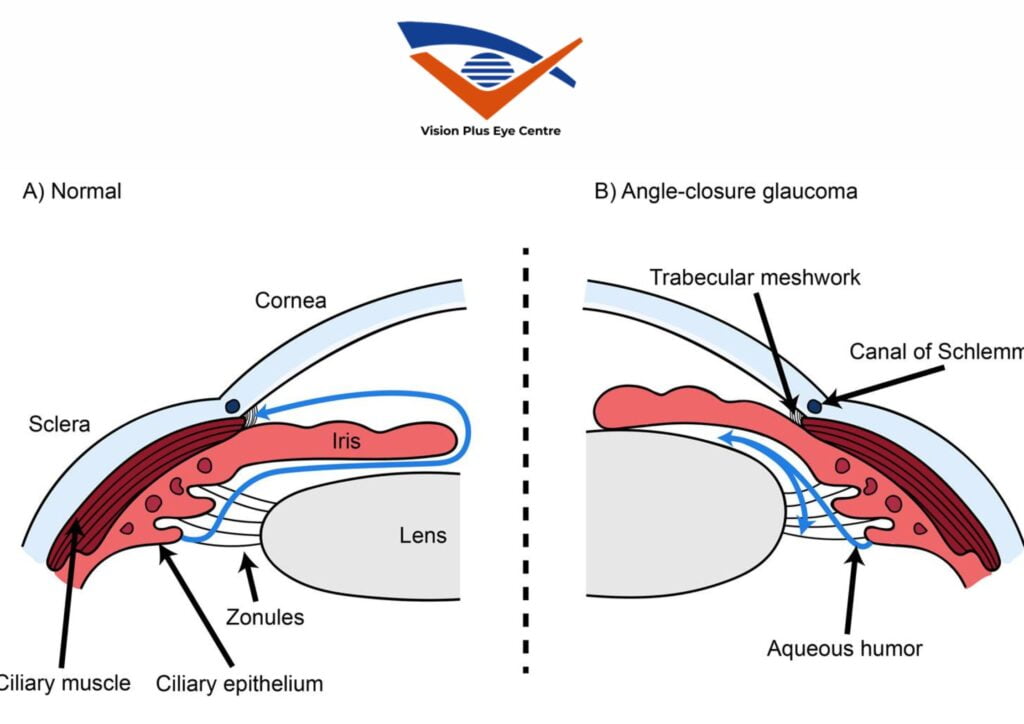
Glaucoma, often referred to as the “silent thief of sight,” is a group of eye conditions that damage the optic nerve and can lead to vision loss or blindness. Among the different types of glaucoma, the two most common are open-angle glaucoma and angle-closure glaucoma. In this comprehensive guide, we’ll explore the differences between these two types of glaucoma, their causes, symptoms, and treatment options.
Understanding Glaucoma
Glaucoma is a progressive eye condition characterized by increased intraocular pressure (IOP), which can damage the optic nerve. The optic nerve is responsible for transmitting visual information from the eye to the brain, and any damage to it can lead to vision loss. While there are several subtypes of glaucoma, the two main categories are open-angle and angle-closure glaucoma.
Open-Angle Glaucoma
Open-angle glaucoma, also known as primary open-angle glaucoma (POAG), is the most common type of glaucoma, accounting for around 90% of all cases. It is often referred to as “wide-angle” glaucoma because the drainage angle of the eye appears normal and open. Despite this open angle, the drainage system of the eye, called the trabecular meshwork, becomes less efficient over time.
Causes:
- The exact cause of open-angle glaucoma is not always clear, but it is often associated with a gradual increase in intraocular pressure due to poor drainage of aqueous humor (the clear fluid inside the eye).
- It may have a genetic component, and some families have a higher risk of developing the condition.
Symptoms:
- Open-angle glaucoma is often asymptomatic in its early stages, making it challenging to detect without regular eye exams.
- As the condition progresses, individuals may notice a gradual loss of peripheral vision, which can lead to tunnel vision.
Treatment:
- Open-angle glaucoma is typically managed with eye drops, laser therapy (like selective laser trabeculoplasty or SLT), and occasionally surgery to improve drainage.
Angle-Closure Glaucoma
Angle-closure glaucoma, also known as closed-angle glaucoma, is less common but considered a medical emergency. In this type of glaucoma, the drainage angle between the iris and the cornea is closed or blocked, leading to a rapid increase in intraocular pressure.
Causes:
- Angle-closure glaucoma may occur due to the narrowing of the drainage angle with age.
- It can also be triggered by a sudden dilation of the pupil, which narrows the drainage angle.
Symptoms:
- Angle-closure glaucoma typically presents with sudden and severe symptoms, including eye pain, headache, blurred vision, halos around lights, nausea, and vomiting.
Treatment:
- Immediate medical attention is required to reduce intraocular pressure. This may involve the use of oral medications, intravenous drugs, or emergency surgery to create a new drainage pathway.
Key Differences: Open-Angle vs. Angle-Closure Glaucoma
- Drainage Angle:
- The primary difference between these two types of glaucoma is the state of the drainage angle. Open-angle glaucoma has a wide and open drainage angle, while angle-closure glaucoma has a blocked or closed drainage angle.
- Symptoms:
- Open-angle glaucoma often progresses slowly and is initially asymptomatic. Angle-closure glaucoma, on the other hand, presents suddenly with severe symptoms, making it a medical emergency.
- Risk Factors:
- Open-angle glaucoma is more common and is associated with factors such as age, family history, and ethnicity. Angle-closure glaucoma is less common and can be triggered by factors like pupil dilation.
- Treatment Approach:
- The treatment for open-angle glaucoma focuses on lowering intraocular pressure through eye drops, laser therapy, or surgery as needed. In contrast, angle-closure glaucoma requires immediate measures to reduce intraocular pressure, including medications and surgery.
Conclusion: Know the Type, Seek Early Detection
Both open-angle and angle-closure glaucoma are serious eye conditions that can lead to vision loss if left untreated. The key to managing glaucoma effectively is early detection through regular eye exams, as both types may be asymptomatic in their early stages. Understanding the differences between these glaucoma types can help individuals and healthcare professionals work together to preserve vision and provide timely treatment when needed.
It’s crucial to remember that this information is for educational purposes and should not replace professional medical advice. If you suspect you have glaucoma or have risk factors for the condition, consult with an ophthalmologist for a comprehensive eye evaluation and personalized guidance on managing your eye health.
At Vision Plus Eye Centre, we’re committed to raising awareness about glaucoma. This sight-threatening condition comes in two primary forms: open-angle and angle-closure. Understanding the differences is crucial for early detection and treatment. Regular eye check-ups at our center can help safeguard your vision.
Call Now at 0120-2481481, 2480480 +91 88003 13134 or email us at info@visionplus.net.in.
Book an Online Appointment: https://visionplus.net.in/contact/

